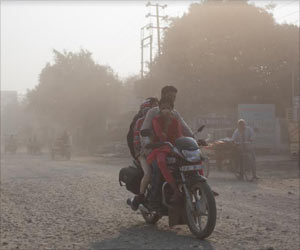Variations in nitrogen oxide exposure were larger by race and ethnicity than by income, age or education, and that those inequities persisted across the decade.

‘Narrowing of the racial gap in nitrogen oxide exposures was driven more by improving air quality than by demographic changes over 10-years.’





The groundbreaking study led by University of Washington researchers estimated exposure to outdoor concentrations of a transportation-related pollutant nitrogen dioxide (NO2) in both 2000 and 2010, based on neighborhoods where people live.It found disparities in NO2 exposure were larger by race and ethnicity than by income, age or education, and that those inequities persisted across the decade.
While absolute differences in exposure to the air pollutant dropped noticeably during that time period for all populations, the relative difference or the gap between pollution levels to which white people and people of color were exposed narrowed only a little.
The study published in Environmental Health Perspectives. The researchers developed a first-of-its-kind model that combines satellite and regulatory measurements with land use data to predict pollution at a neighborhood level throughout the United States.
The positive news is that across the U.S., average exposure to NO2 for all races and income levels dropped from 2000 to 2010. Measured in parts per billion (ppb), estimated average annual NO2 exposure decreased from 17.6 to 10.7 ppb for nonwhite populations, and from 12.6 to 7.8 ppb for white populations.
Advertisement
Furthermore, in 2000, concentrations of NO2 in neighborhoods with the highest proportion of nonwhite residents were 2.5 times higher than in neighborhoods with the lowest proportion of nonwhite residents. In 2010, that value increased slightly, to 2.7 times higher.
Advertisement
"The finding that shocks us is that when it comes to how much NO2 a person breathes, it's still race that matters," said senior author Julian Marshall, UW professor of civil and environmental engineering.
"At any income level low to medium to high there's a persistent gap by race, which is completely indefensible. It says a lot about how segregated neighborhoods still are and how things are segregated," Marshall said.
NO2 comes from sources such as vehicle exhaust, power plants and off-road equipment and is one of six important "criteria air pollutants" monitored by the Environmental Protection Agency. It has been linked to asthma symptoms, increased susceptibility to respiratory problems and heart disease.
The research team, which began their work at the University of Minnesota, previously analyzed NO2 concentrations for the year 2006 by race, income and other demographic factors identified in the U.S. Census. The team's air pollution model, which combines existing EPA air quality monitoring and satellite data with detailed land use information, allows them to accurately predict pollution concentrations across the country at the U.S. Census block level information previously unavailable at that scale.
In this first longitudinal study of its kind, researchers wanted to examine how much progress was made in addressing inequities in NO2 exposure over a decade. They compared environmental injustice metrics in 2000 and 2010 on a national basis and by region, state, county and urban areas.
On the whole, researchers said, policies to reduce NO2 air pollution are working. But the finding that exposure differences are larger by race and ethnicity than by income, age or education was equally true in 2010 as in 2000.
"Everyone benefited from clean air regulations and less pollution; that's the good news," said lead author and UW civil and environmental engineering doctoral student Lara Clark. "But the fact that there is a pervasive gap in exposure to NO2 by race and that the relative gap was more or less preserved over a decade is the bad news."
The UW study did not explore the underlying reasons for that gap, but its findings are consistent with previous research. Both racial minorities and low-income households are disproportionately likely to live near a major road where transportation-related pollution is typically highest. U.S. cities, in general, also tend to be more segregated by race and ethnicity than by income.
The UW team did conclude that the narrowing of the racial gap in NO2 exposures was driven more by improving air quality than by demographic changes over the 10-year period.
"That suggests that air pollution is coming down faster than cities are becoming less segregated," Marshall said.
Next steps for the research team include looking at how changes in demographics, industry and urban form at the city level affect NO2 exposure, and developing similar models for other EPA criteria air pollutants.
Source-Eurekalert









